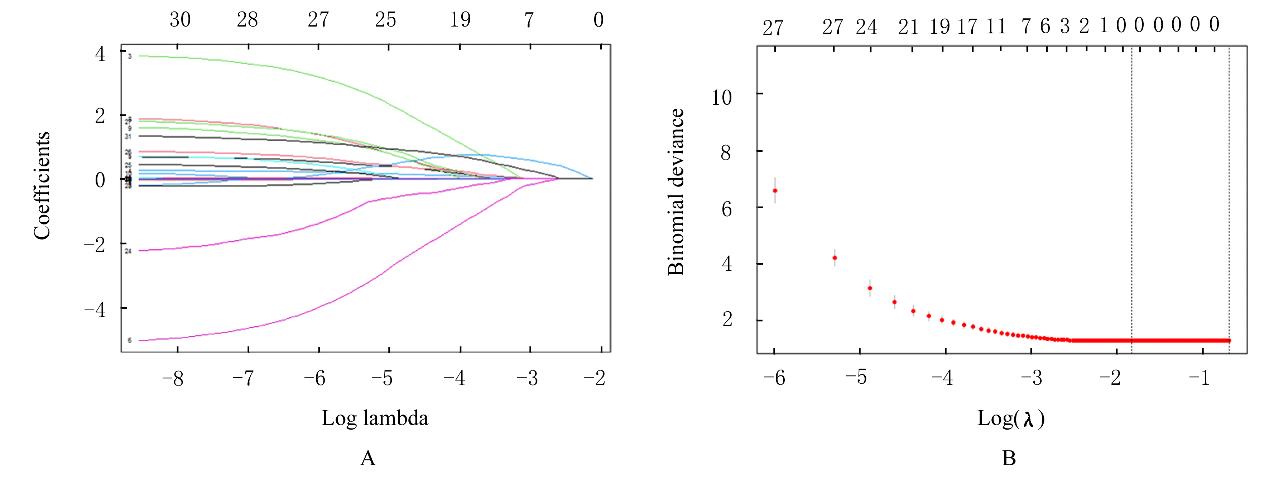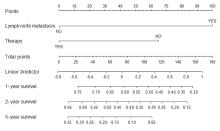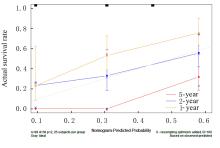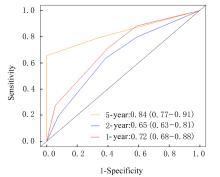吉林大学学报(医学版) ›› 2022, Vol. 48 ›› Issue (4): 979-987.doi: 10.13481/j.1671-587X.20220418
胆管癌根治性切除术后患者预后相关因素分析和生存预测模型构建
牛英杰1,查勇1,李思嘉2,王青2,唐诗聪2( ),李红阳1(
),李红阳1( )
)
- 1.云南省肿瘤医院 昆明医科大学第三附属医院肝胆胰外科,云南 昆明 650118
2.云南省肿瘤医院 昆明医科大学第三附属医院乳腺外一科,云南 昆明 650118
Analysis on prognosis related factors of patients with cholangiocarcinoma after radical resection and establishment of survival prediction model
Yingjie NIU1,Yong ZHA1,Sijia LI2,Qing WANG2,Shicong TANG2( ),Hongyang LI1(
),Hongyang LI1( )
)
- 1.Department of Hepatobiliary Pancreatic Surgery,Cancer Hospital of Yunnan Province,Third Affiliated Hospital,Kunming Medical University,Kunming 650118,China
2.Department of Breast Surgery,Cancer Hospital of Yunnan Province,Third Affiliated Hospital,Kunming Medical University,Kunming 650118,China
摘要: 探讨胆管癌(CCA)根治性切除术(根治术)后患者复发和生存的影响因素,建立列线图预测术后生存时间。 回顾性分析本院行CCA根治术的89例患者临床和病理资料,中位无病生存期(DFS)和总生存期(OS)分别为10和13个月。采用Kaplan-Meier生存分析和Cox回归模型分析临床病理特征对CCA患者DFS和OS的影响;采用R软件进行LASSO回归,评估CCA患者术后复发的相关影响因素。建立列线图预测患者术后OS,并通过一致性指数(C-index)、校准曲线和受试者工作特征曲线(ROC)下面积(AUC)评估列线图的预测效能。 单因素分析,糖尿病(χ2=5.204,P=0.023)、糖类抗原19-9(CA19-9)(χ2=7.694,P=0.006)、糖类抗原125(CA125)(χ2=6.908,P=0.009)、糖类抗原242(CA242)(χ2=10.712,P=0.001)、肿瘤大小(χ2=4.310,P=0.038)和淋巴结转移(χ2=16.883,P<0.001)是影响CCA患者术后DFS的独立危险因素。Kaplan-Meier生存分析,癌胚抗原(CEA)(χ2=5.188,P=0.023)、CA19-9(χ2=9.324,P=0.002)、CA125(χ2=9.568,P=0.002)、CA242(χ2=19.119,P<0.001)、前白蛋白(χ2=4.370,P=0.037)、丙氨酸氨基转移酶(ALT)(χ2=4.072,P=0.045)、天冬氨酸氨基转移酶(AST)(χ2=6.401,P=0.011)、碱性磷酸酶(ALP)(χ2=4.682,P=0.045)、淋巴结转移(χ2=11.739,P<0.001)、脉管癌栓(χ2=5.940,P=0.015)、血管侵犯(χ2=4.892,P=0.027)和术后辅助治疗(χ2=4.011,P=0.045)是影响CCA患者术后生存的危险因素。LASSO回归和Cox多因素分析,淋巴结转移是CCA根治术患者术后复发的独立危险因素(OR=3.067,95%CI=1.192~8.252,P=0.022),淋巴结转移(HR=2.094,95%CI = 1.074~4.083,P=0.030)和术后辅助治疗(HR=0.374,95%CI = 0.190~0.736,P=0.004)是影响CCA患者生存的独立因素。建立列线图预测CCA患者的OS,其C-index为0.697,第1、2和5年生存率的AUC分别为0.72(95%CI:0.68~0.88)、0.65(95%CI:0.63~0.81)和0.84(95%CI:0.77~0.91)。 CCA患者预后较差,术后生存率低,淋巴结转移是影响患者复发和生存的共同独立危险因素,结合有无术后辅助治疗构建的列线图对CCA患者术后的生存期有较好的预测效能。
中图分类号:
- R735.7








